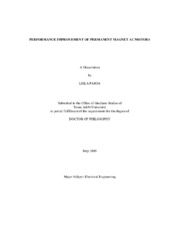| dc.description.abstract | Multi-phase motors have several advantages over the traditional three-phase motors.
In this study, the additional degrees of freedom available in five-phase permanent
magnet motors have been used for three purposes: 1) enhancing the torque producing
capability of the motor, 2) improving the reliability of the system, and 3) better adjusting
of the torque and flux linkages of the five-phase direct torque controlled system.
1) Due to the fact that space and time harmonics of the same orders will contribute
positively to output torque, a five-phase permanent magnet motor with quasi-rectangular
back-EMF waveform is supplied with combined fundamental and third harmonic of
currents. For modeling and analysis of the motor a 0 3 3 1 1 q d q d frame of reference is
defined where 1 1q d rotates at the synchronous speed and 3 3q d rotates at the three times
synchronous speed. Based on the mathematical model in the 0 3 3 1 1 q d q d frame of
reference, it is shown that this system while having a higher torque density with respect
to a conventional permanent magnet synchronous machine, is also compatible with
vector control algorithm.
2) A resilient current control of the five-phase permanent motor with both sinusoidal
and trapezoidal back-EMF waveforms under asymmetrical fault condition is proposed.
In this scheme, the stator MMF is kept unchanged during healthy and faulty condition.
Therefore, the five-phase permanent magnet motor operates continuously and steadily
without additional hardware and just by modifying the control algorithm in case of loss
of up to two phases. The feature is of major importance in some specific applications
where high reliability is required.
3) High torque and flux ripple are the major drawbacks of a three-phase direct
torque controlled system. The number of space voltage vectors directly influences the
performance of DTC system. A five-phase drive, while benefiting from other advantages
of high order phase drives, has inherently 32 space voltage vectors which permits better
flexibility in selecting the switching states and finer adjustment of flux and torque. A
sensorless direct torque control of five-phase permanent magnet motor is implemented.
Speed information is obtained based on the position of stator flux linkages and load
angle.
Experiments have been conducted on a 5kW five-phase surface mount permanent
magnet motor and a 3kW five-phase interior permanent magnet motor by using
TMS320C32 DSP. The results obtained are consistent with theoretical studies and
simulation analysis, which further demonstrate the feasibility and practical significance
of the five-phase permanent magnet motor drives. | en |


